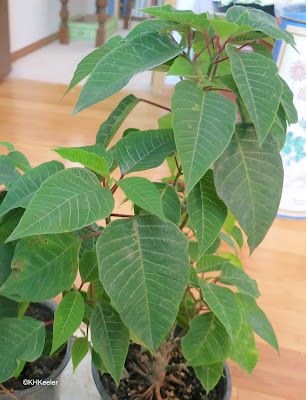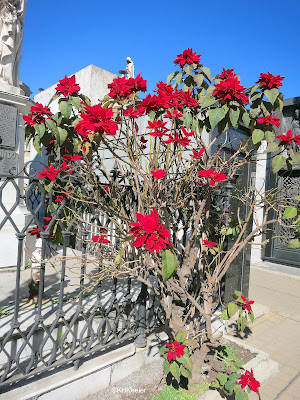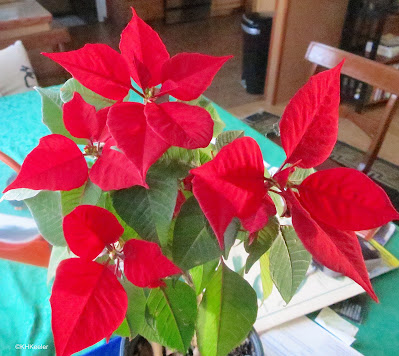 |
| poinsettia/ cuetlaxochitl/ flor de la noche buena, Euphorbia pulcherrima, |
Most people have no idea of the history of the plants around them. Plant species go back thousands of years, so they will have interacted with dozens of human cultures over time and space. Individual humans learn the name of familiar plants from a relative or friend and are rarely taught about its history.
I learned poinsettia as a name, struggled a bit to remember and spell it, but never, before writing a blog post six years ago (link), wondered what a poinset was.
Biology: The poinsettia/ cuetlaxochitl/ flor de la noche buena, scientific name Euphorbia pulcherrima, is a big shrubby species in the spurge family, Euphorbiaceae. It is native from Mexico to Guatemala. It develops large bright red bracts around the flowers as it comes into bloom. Flowering is controlled by light and occurs when the days become shorter than nights. Consequently it makes its dramatic transition--all rich green to covered in striking red--just about the solstice, for Christmas.
 |
| Euphorbia pulcherrima, most of the year (same plant as in the first photo) |
History with Humans: Cultures in Central America cultivated it before the Europeans arrived. They named it in their own languages. When the Spanish arrived, they incorportated E. pulcherrima into Chrisitianity as heralding Christmas, complete with miracles, and called it flor de la noche buena, "flower of the good night" meaning "Christmas eve flower." It was unknown in the United States until the early 1800s. Joel Robert Poinsett (1779-1851), the first minister to Mexico from the United States, apprently sent the plant to Bartram Gardens in Philadelphia and promoted it. Poinsett called it "painted leaf" or "Mexican flame flower."
New to science, the plant was named Poinsettia pulcherrima in 1836 (pulcherima means "most beautiful"), which led to the common name poinsettia. However, reanalysis showed it was a member of the big genus Euphorbia, so the name became Euphorbia pulcherima.
People in colder parts the U. S. wouldn't know this plant--it is very frost sensitive--except for the Eckes of Paul Ecke Ranch of southern California. Paul Ecke Sr. (1894-1991) developed a method of growing E. pulcherrima that produced a compact plant in a flowerpot, and Paul Ecke Jr. promoted it very energetically. They built a seasonal demand for tens of millions of plants.
When I wrote about it six years ago I got much of the story I told above. It is full of issues to think about.
 |
| Euphorbia pulcherrima, growing in a region without significant frost |
>The Aztecs saw in cuetlaxochitl a reference to their gods periodically requiring human sacrifices. Like their altars, it turned blood-red part of the year. There is other symbolism to the plant, for example heralding the solstice, and a larger cultural context, but sacrifice, including human sacrifice, was an important part of Aztec religion. I try to understand human sacrifice but I don't like it, so I find Euphorbia pulcherrima's Aztec history a mix of positives and negatives.
>The Spanish conquerors superimposed Christian symbolism on E. pulcherrima. I think the miracle stories unlikely, but I recognize the honest religious feeling. Generations of people have loved flor de la nochebuena as a Christian symbol. But it was case of quite intentional cultural appropriation.
>Poinsett was an American patriot, a congressman, ambassador, and Secretary of War. He was an enthusiastic amateur botanist, a patron of the arts, and fellow of the American Academy of Arts and Sciences. As the first U.S. minister to Mexico, he so involved himself in Mexican politics that Mexico has a term, poinsettismo, for officious Yankee meddling (read more in the Washington Post link). He was a slave owner, a friend of Andrew Jackson, and a supporter westward expansion. As Secretary of War (1837-1841), he ordered the removal of the Cherokee (the Trail of Tears) and presided over the Second Seminole War (link). Seen from 2022, he did a lot that was dreadful as well as a lot of that was praise-worthy.
> Few of us would know Euphorbia pulcherrima if it hadn't been a commercial success. But Euphorbia pulcherrima plants are treated as disposables. Some 70 million are sold in November and December each year. The vast majority of those are thrown away in January. That bothers me because they are living things. Is this on balance good or bad?
 |
| Euphorbia pulcherimma for holiday decoration |
Euphorbia pulcherrima's story can be looked at from many angles. Those collide when choosing a common name. As noted, I find much of Poinsett's career offensive, although I acknowledge he was a product of his times. Meanwhile, the Aztecs are not the only Mesoamerican culture with a claim on Euphorbia pulcherrima. Paul Schifferes, writing on Facebook, wrote "You could also choose aijoyó, which is a Zoque word, gule-tiini which is Zapateca, lipa-que-pojua, from Chontal or pastushtln which is a Totonac term....There are many indigenous languages and the Mexica were not the only group to interact with the plant." And the plant has many common names in European languages. Medicinenet (link) offers these other names: Christmas flower, Easter flower, étoile de noël, fleur pentecôte, flor de pascua, lobster flower plant, lobsterplant, Mexican flame leaf, paintedleaf, papagallo, pastora. If you search on google for Christmas star plant, you get E. pulcherrima, so there may be other names too.
How do you choose the plant name you use? Names are about communication; much as I'd like to call Euphorbia pulcherrima paintedleaf, almost no one will know what plant I am talking about.
But, importantly, common names are the names people use. While they are probably influenced by the names in important publications, or today, websites, they are (as I have ranted occassionally) not under anyone's control or at all uniform.
History is messy. Good and bad is not as simple as I thought when I was a child. Euphorbia pulcherrima makes a good example of the questions and ambiguities of history. What to call it can seem trivial; it is just a plant name! But it is entangled in human history, and we'd like our language to reflect our values. Easier said than done.
Such a lovely plant; such a pile of baggage attached to it by humans!
Comments and corrections welcome.
References
History Crunch Writers. 2018. Aztec Religion. link (Accessed 1/1/22)
Lack, H. W. 2011. The discovery, naming and typification of Euphorbia pulcherrima (Euphorbiaceae). Wildenowia. 41(2): 301-309. On BioOne Complete: wi.41.41212.pdf
Sesma, G. A. 2021. Cuetlaxochitl: a Gift of Light from Mexico. curanderismo.com link (Accessed 12/23/21).
Taylor, J. M., R. G. Lopez, C. J. Currey and J. Janick. The Poinsettia: History and Transformation. Chronica Horticulturae. 51 (3): 23-28
Three Sonorans 2012. Poinsettia: the Christmas flower and the racist history behind La Cuetlaxochitl. TSON.news link (Accessed 12/21/21).
Masa America 2021, Cuetlaxochitl: The Poinsettia masaamerica.foot.blog link (Accessed 12/29/21). Detailed consideration of the Nuhuatl name.
Kathy Keeler, A Wandering Botanist
More at awanderingbotanist.com
Join me on Facebook: https://www.facebook.com/AWanderingBotanist

No comments:
Post a Comment